parking brake SSANGYONG KORANDO 1997 Service Repair Manual
[x] Cancel search | Manufacturer: SSANGYONG, Model Year: 1997, Model line: KORANDO, Model: SSANGYONG KORANDO 1997Pages: 2053, PDF Size: 88.33 MB
Page 10 of 2053
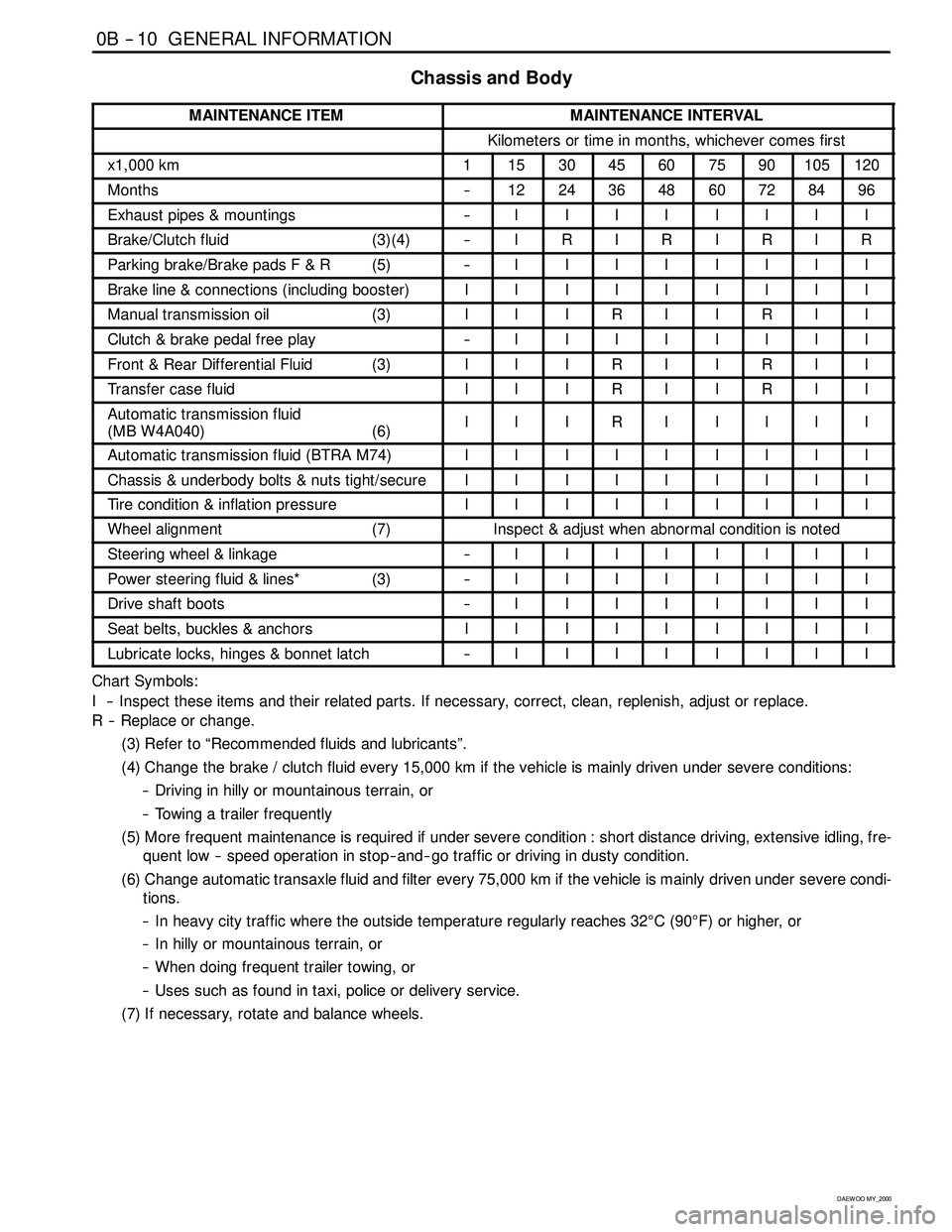
0B -- 10 GENERAL INFORMATION
D AEW OO M Y_2000
Chassis and Body
MAINTENANCE ITEMMAINTENANCE INTERVAL
Kilometers or time in months, whichever comes first
x1,000 km1153045607590105120
Months--1224364860728496
Exhaust pipes & mountings--IIIIIIII
Brake/Clutch fluid (3)(4)--IRIRIRIR
Parking brake/Brake pads F & R (5)--IIIIIIII
Brake line & connections (including booster)IIIIIIIII
Manual transmission oil (3)IIIRIIRII
Clutch & brake pedal free play--IIIIIIII
Front & Rear Differential Fluid (3)IIIRIIRII
Transfer case fluidIIIRIIRII
Automatic transmission fluid
(MB W4A040) (6)IIIRIIIII
Automatic transmission fluid (BTRA M74)IIIIIIIII
Chassis & underbody bolts & nuts tight/secureIIIIIIIII
Tire condition & inflation pressureIIIIIIIII
Wheel alignment (7)Inspect & adjust when abnormal condition is noted
Steering wheel & linkage--IIIIIIII
Power steering fluid & lines* (3)--IIIIIIII
Drive shaft boots--IIIIIIII
Seat belts, buckles & anchorsIIIIIIIII
Lubricate locks, hinges & bonnet latch--IIIIIIII
Chart Symbols:
I -- Inspect these items and their related parts. If necessary, correct, clean, replenish, adjust or replace.
R -- Replace or change.
(3) Refer to “Recommended fluids and lubricants”.
(4) Change the brake / clutch fluid every 15,000 km if the vehicle is mainly driven under severe conditions:
-- Driving in hilly or mountainous terrain, or
-- Towing a trailer frequently
(5) More frequent maintenance is required if under severe condition : short distance driving, extensive idling, fre-
quent low -- speed operation in stop-- and-- go traffic or driving in dusty condition.
(6) Change automatic transaxle fluid and filter every 75,000 km if the vehicle is mainly driven under severe condi-
tions.
-- In heavy city traffic where the outside temperature regularly reaches 32°C(90°F) or higher, or
-- In hilly or mountainous terrain, or
-- When doing frequent trailer towing, or
-- Uses such as found in taxi, police or delivery service.
(7) If necessary, rotate and balance wheels.
Page 12 of 2053
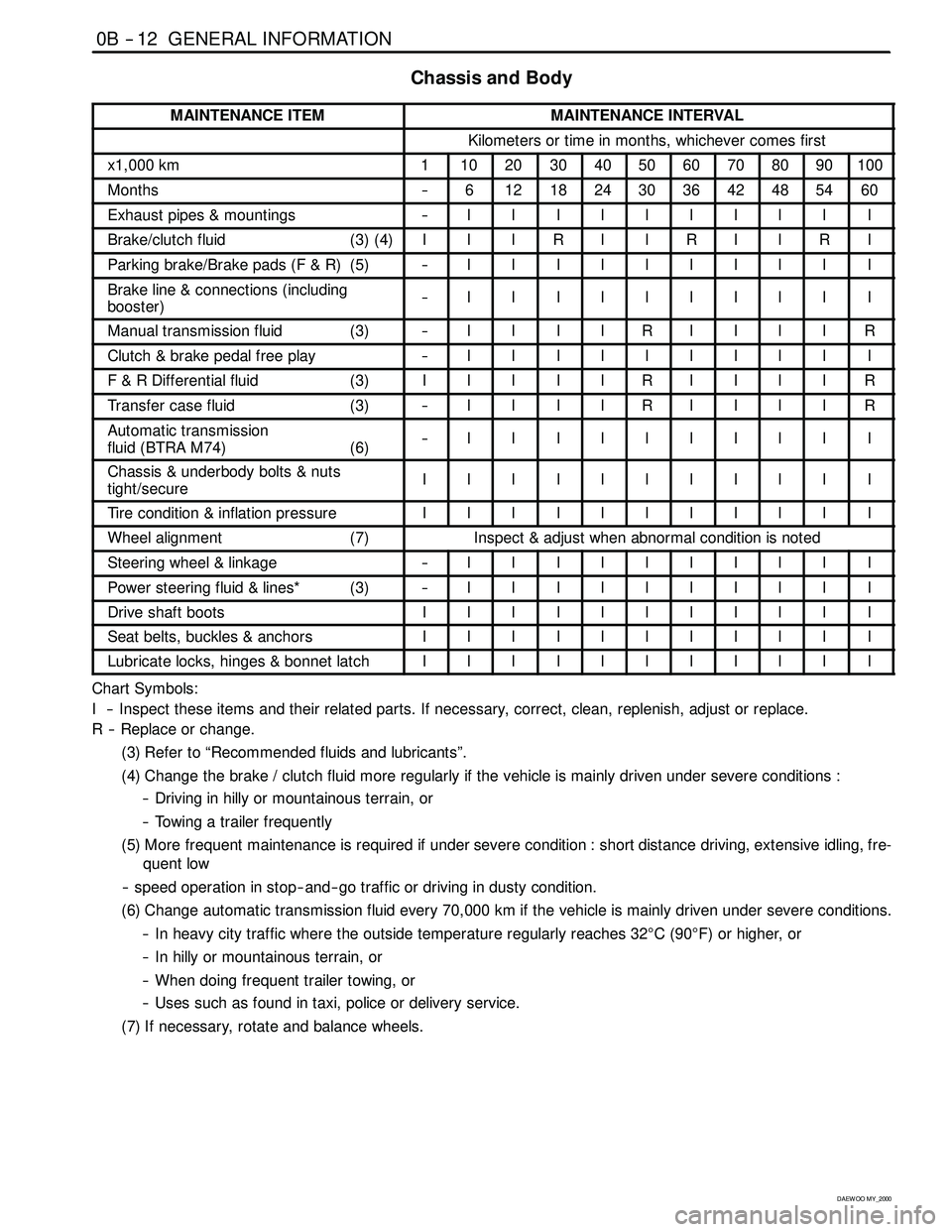
0B -- 12 GENERAL INFORMATION
D AEW OO M Y_2000
Chassis and Body
MAINTENANCE ITEMMAINTENANCE INTERVAL
Kilometers or time in months, whichever comes first
x1,000 km1102030405060708090100
Months--6121824303642485460
Exhaust pipes & mountings--IIIIIIIIII
Brake/clutch fluid (3) (4)IIIRIIRIIRI
Parking brake/Brake pads (F & R) (5)--IIIIIIIIII
Brake line & connections (including
booster)--IIIIIIIIII
Manual transmission fluid (3)--IIIIRIIIIR
Clutch & brake pedal free play--IIIIIIIIII
F & R Differential fluid (3)IIIIIRIIIIR
Transfer case fluid (3)--IIIIRIIIIR
Automatic transmission
fluid (BTRA M74) (6)--IIIIIIIIII
Chassis & underbody bolts & nuts
tight/secureIIIIIIIIIII
Tire condition & inflation pressureIIIIIIIIIII
Wheel alignment (7)Inspect & adjust when abnormal condition is noted
Steering wheel & linkage--IIIIIIIIII
Power steering fluid & lines* (3)--IIIIIIIIII
Drive shaft bootsIIIIIIIIIII
Seat belts, buckles & anchorsIIIIIIIIIII
Lubricate locks, hinges & bonnet latchIIIIIIIIIII
Chart Symbols:
I -- Inspect these items and their related parts. If necessary, correct, clean, replenish, adjust or replace.
R -- Replace or change.
(3) Refer to “Recommended fluids and lubricants”.
(4) Change the brake / clutch fluid more regularly if the vehicle is mainly driven under severe conditions :
-- Driving in hilly or mountainous terrain, or
-- Towing a trailer frequently
(5) More frequent maintenance is required if under severe condition : short distance driving, extensive idling, fre-
quent low
-- speed operation in stop-- and-- go traffic or driving in dusty condition.
(6) Change automatic transmission fluid every 70,000 km if the vehicle is mainly driven under severe conditions.
-- In heavy city traffic where the outside temperature regularly reaches 32°C(90°F) or higher, or
-- In hilly or mountainous terrain, or
-- When doing frequent trailer towing, or
-- Uses such as found in taxi, police or delivery service.
(7) If necessary, rotate and balance wheels.
Page 13 of 2053
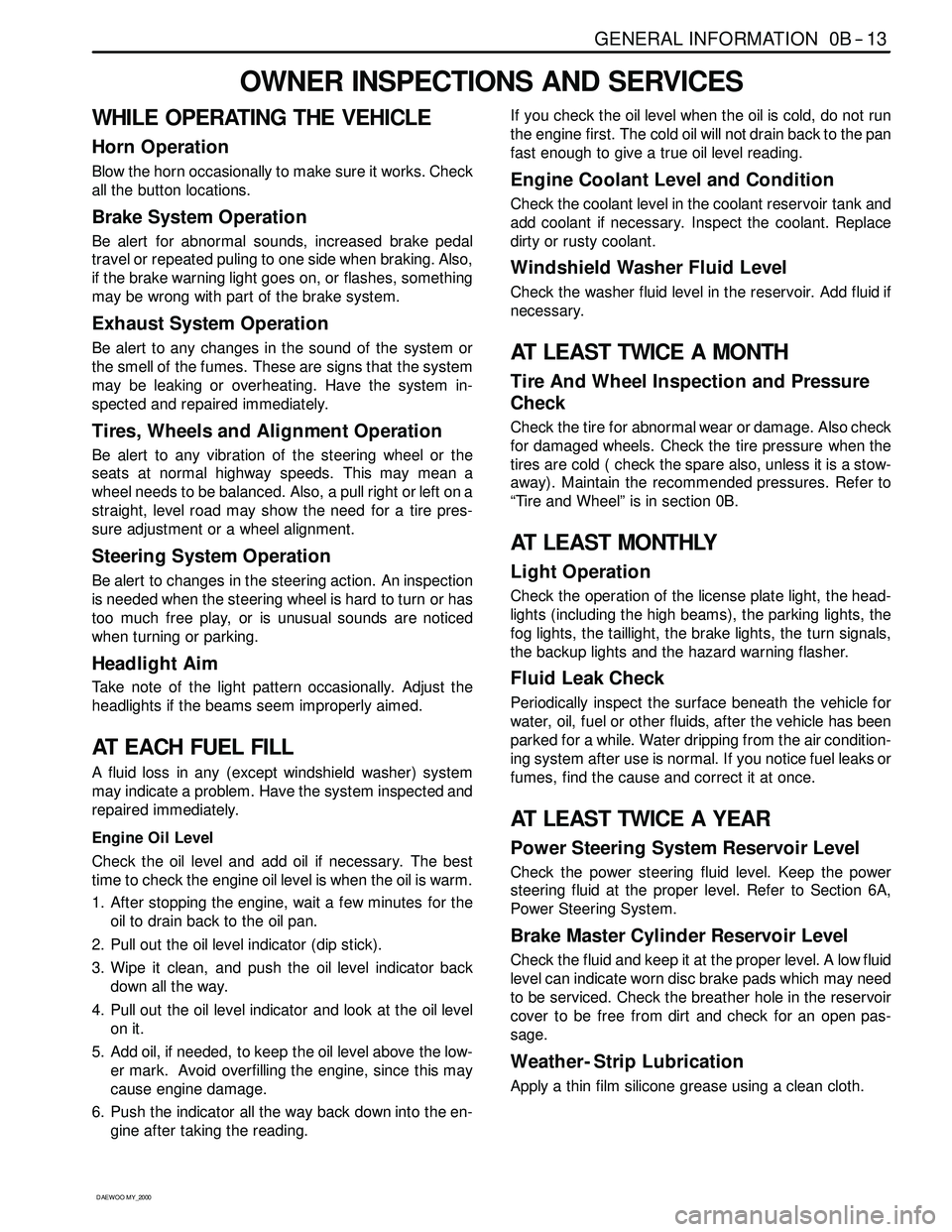
GENERAL INFORMATION 0B -- 13
D AEW OO M Y_2000
OWNER INSPECTIONS AND SERVICES
WHILE OPERATING THE VEHICLE
Horn Operation
Blow the horn occasionally to make sure it works. Check
all the button locations.
Brake System Operation
Be alert for abnormal sounds, increased brake pedal
travel or repeated puling to one side when braking. Also,
if the brake warning light goes on, or flashes, something
may be wrong with part of the brake system.
Exhaust System Operation
Be alert to any changes inthe sound of the system or
the smell of the fumes. These are signs that the system
may be leaking or overheating. Have the system in-
spected and repaired immediately.
Tires, Wheels and Alignment Operation
Be alert to any vibration of the steering wheel or the
seats at normal highway speeds. This may mean a
wheel needs to be balanced. Also, a pull right or left on a
straight, level road may show the need for a tire pres-
sure adjustment or a wheel alignment.
Steering System Operation
Be alert to changes in the steering action. An inspection
is needed when the steering wheel is hard to turn or has
too much free play, or is unusual sounds are noticed
when turning or parking.
Headlight Aim
Take note of the light pattern occasionally. Adjust the
headlights if the beams seem improperly aimed.
AT EACH FUEL FILL
A fluid loss in any (except windshield washer) system
may indicate a problem. Have the system inspected and
repaired immediately.
Engine Oil Level
Check the oil level and add oil if necessary. The best
time to check the engine oil level is when the oil is warm.
1. After stopping the engine, wait a few minutes for the
oil to drain back to the oil pan.
2. Pull out the oil level indicator (dip stick).
3. Wipe it clean, and push the oil level indicator back
down all the way.
4. Pull out the oil level indicator and look at the oil level
on it.
5. Add oil, if needed, to keep the oil level above the low-
er mark. Avoid overfilling theengine, since this may
cause engine damage.
6. Push the indicator all the way back down into the en-
gine after taking the reading.If you check the oil level when the oil is cold, do not run
the engine first. The cold oil will not drain back to the pan
fast enough to give a true oil level reading.
Engine Coolant Level and Condition
Check the coolant level in the coolant reservoir tank and
add coolant if necessary. Inspect the coolant. Replace
dirty or rusty coolant.
Windshield Washer Fluid Level
Check the washer fluid level in the reservoir. Add fluid if
necessary.
AT LEAST TWICE A MONTH
Tire And Wheel Inspection and Pressure
Check
Check the tire for abnormal wear or damage. Also check
for damaged wheels. Check the tire pressure when the
tires are cold ( check the spare also, unless it is a stow-
away). Maintain the recommended pressures. Refer to
“Tire and Wheel” is in section 0B.
AT LEAST MONTHLY
Light Operation
Check the operation of the license plate light, the head-
lights (including the high beams), the parking lights, the
fog lights, the taillight, the brake lights, the turn signals,
the backup lights and the hazard warning flasher.
Fluid Leak Check
Periodically inspect the surface beneath the vehicle for
water, oil, fuel or other fluids, after the vehicle has been
parked for a while. Water dripping from the air condition-
ing system after use is normal. If you notice fuel leaks or
fumes, find the cause and correct it at once.
AT LEAST TWICE A YEAR
Power Steering System Reservoir Level
Check the power steering fluid level. Keep the power
steering fluid at the proper level. Refer to Section 6A,
Power Steering System.
Brake Master Cylinder Reservoir Level
Check the fluid and keep it at the proper level. A low fluid
level can indicate worn disc brake pads which may need
to be serviced. Check the breather hole in the reservoir
cover to be free from dirt and check for an open pas-
sage.
Weather- Strip Lubrication
Apply a thin film silicone grease using a clean cloth.
Page 14 of 2053
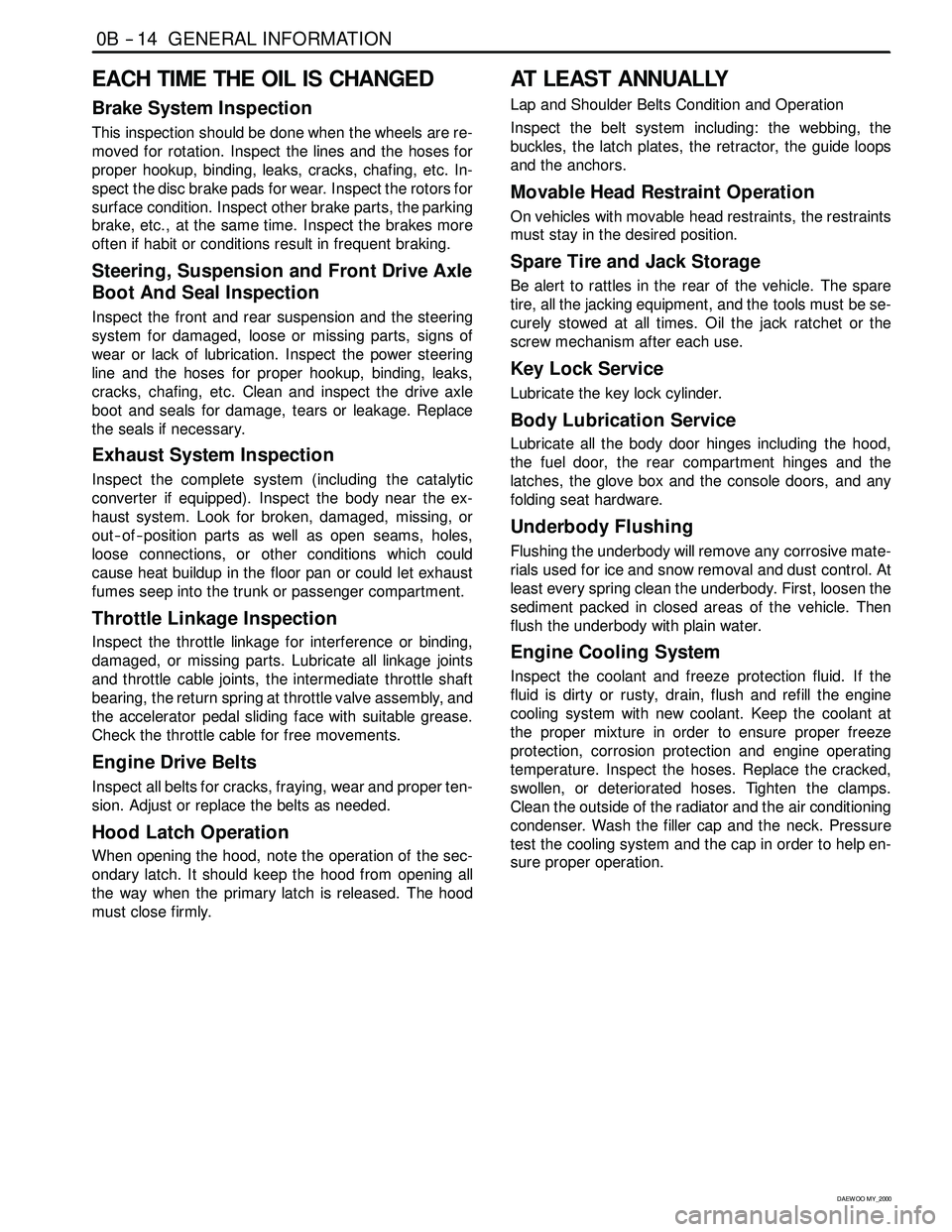
0B -- 14 GENERAL INFORMATION
D AEW OO M Y_2000
EACH TIME THE OIL IS CHANGED
Brake System Inspection
This inspection should be done when the wheels are re-
moved for rotation. Inspect the lines and the hoses for
proper hookup, binding, leaks, cracks, chafing, etc. In-
spect the disc brake pads for wear. Inspect the rotors for
surface condition. Inspect other brake parts, the parking
brake, etc., at the same time. Inspect the brakes more
often if habit or conditions result in frequent braking.
Steering, Suspension and Front Drive Axle
Boot And Seal Inspection
Inspect the front and rear suspension and the steering
system for damaged, loose or missing parts, signs of
wear or lack of lubrication. Inspect the power steering
line and the hoses for proper hookup, binding, leaks,
cracks, chafing, etc. Clean and inspect the drive axle
boot and seals for damage, tears or leakage. Replace
the seals if necessary.
Exhaust System Inspection
Inspect the complete system (including the catalytic
converter if equipped). Inspect the body near the ex-
haust system. Look for broken, damaged, missing, or
out -- of -- position parts as well as open seams, holes,
loose connections, or other conditions which could
cause heat buildup in the floor pan or could let exhaust
fumes seep into the trunk or passenger compartment.
Throttle Linkage Inspection
Inspect the throttle linkage for interference or binding,
damaged, or missing parts. Lubricate all linkage joints
and throttle cable joints, the intermediate throttle shaft
bearing, the return spring at throttle valve assembly, and
the accelerator pedal sliding face with suitable grease.
Check the throttle cable for free movements.
Engine Drive Belts
Inspect all belts for cracks, fraying, wear and proper ten-
sion. Adjust or replace the belts as needed.
Hood Latch Operation
When opening the hood, note the operation of the sec-
ondary latch. It should keep the hood from opening all
the way when the primary latch is released. The hood
must close firmly.
AT LEAST ANNUALLY
Lap and Shoulder Belts Condition and Operation
Inspect the belt system including: the webbing, the
buckles, the latch plates, the retractor, the guide loops
and the anchors.
Movable Head Restraint Operation
On vehicles with movable head restraints, the restraints
must stay in the desired position.
Spare Tire and Jack Storage
Be alert to rattles in the rear of the vehicle. The spare
tire, all the jacking equipment, and the tools must be se-
curely stowed at all times. Oil the jack ratchet or the
screw mechanism after each use.
Key Lock Service
Lubricate the key lock cylinder.
Body Lubrication Service
Lubricate all the body door hinges including the hood,
the fuel door, the rear compartment hinges and the
latches, the glove box and the console doors, and any
folding seat hardware.
Underbody Flushing
Flushing the underbody will remove any corrosive mate-
rials used for ice and snow removal and dust control. At
least every spring clean the underbody. First, loosen the
sediment packed in closed areas of the vehicle. Then
flush the underbody with plain water.
Engine Cooling System
Inspect the coolant and freeze protection fluid. If the
fluid is dirty or rusty, drain, flush and refill the engine
cooling system with new coolant. Keep the coolant at
the proper mixture in order to ensure proper freeze
protection, corrosion protection and engine operating
temperature. Inspect the hoses. Replace the cracked,
swollen, or deteriorated hoses. Tighten the clamps.
Clean the outside of the radiator and the air conditioning
condenser. Wash the filler cap and the neck. Pressure
test the cooling system and the cap in order to help en-
sure proper operation.
Page 15 of 2053
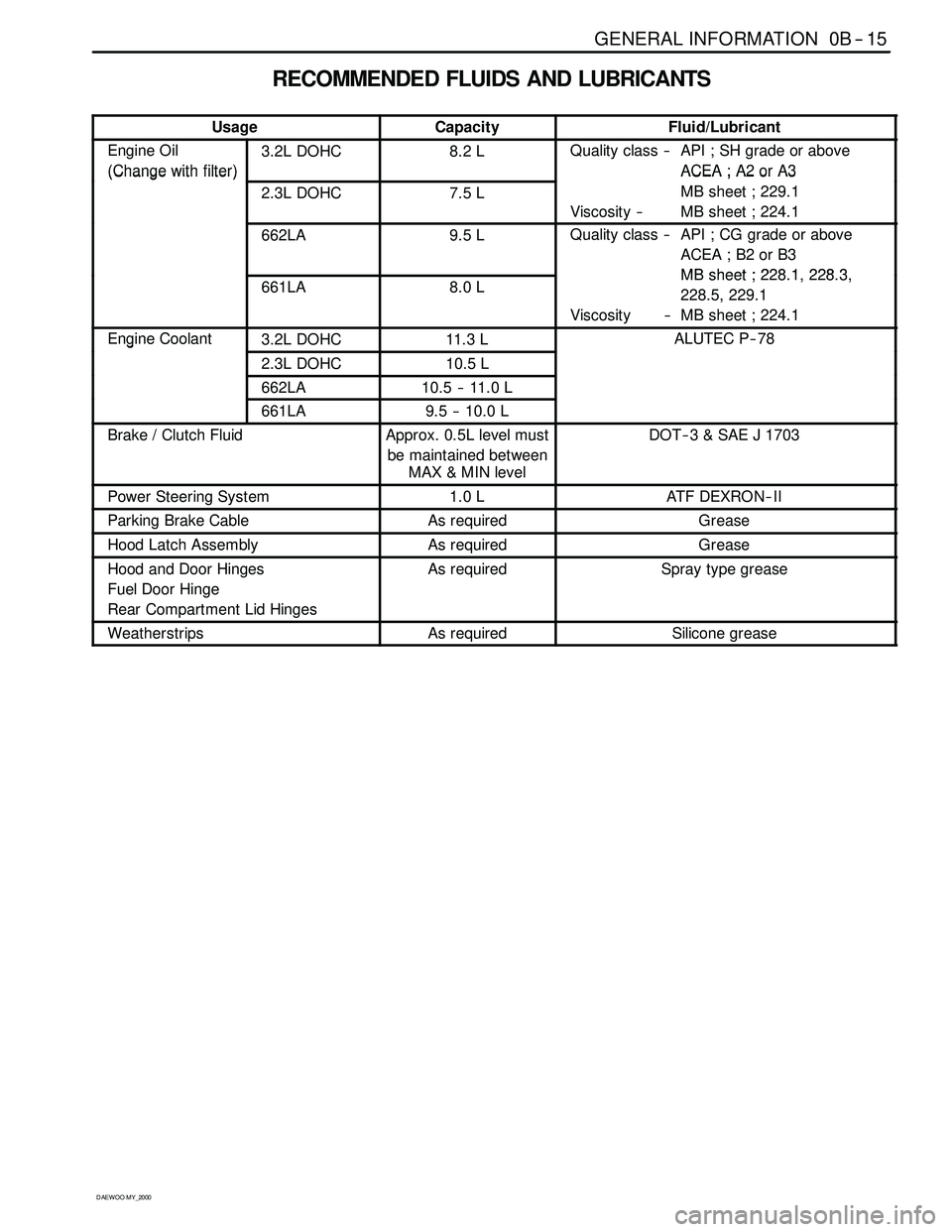
GENERAL INFORMATION 0B -- 15
D AEW OO M Y_2000
RECOMMENDED FLUIDS AND LUBRICANTS
UsageCapacityFluid/Lubricant
Engine Oil
(Change with filter)3.2L DOHC8.2 LQuality class -- API ; SH grade or above
ACEA ; A2 or A3
(Changewithfilter)
2.3L DOHC7.5 L
ACEA;A2orA3
MB sheet ; 229.1
Viscosity -- MB sheet ; 224.1
662LA9.5 LQuality class -- API ; CG grade or above
ACEA ; B2 or B3
MBsheet;22812283661LA8.0 LMBsheet ; 228.1, 228.3,
228.5, 229.1
Viscosity -- MB sheet ; 224.1
Engine Coolant3.2L DOHC11. 3 LALUTEC P-- 78g
2.3L DOHC10.5 L
662LA10.5 -- 11.0 L
661LA9.5 -- 10.0 L
Brake / Clutch FluidApprox. 0.5L level must
be maintained between
MAX&MINlevelDOT -- 3 & SAE J 1703
Power Steering System1.0 LATF DEXRON--II
Parking Brake CableAs requiredGrease
Hood Latch AssemblyAs requiredGrease
Hood and Door Hinges
Fuel Door Hinge
Rear Compartment Lid HingesAs requiredSpray type grease
WeatherstripsAs requiredSilicone grease
Page 29 of 2053
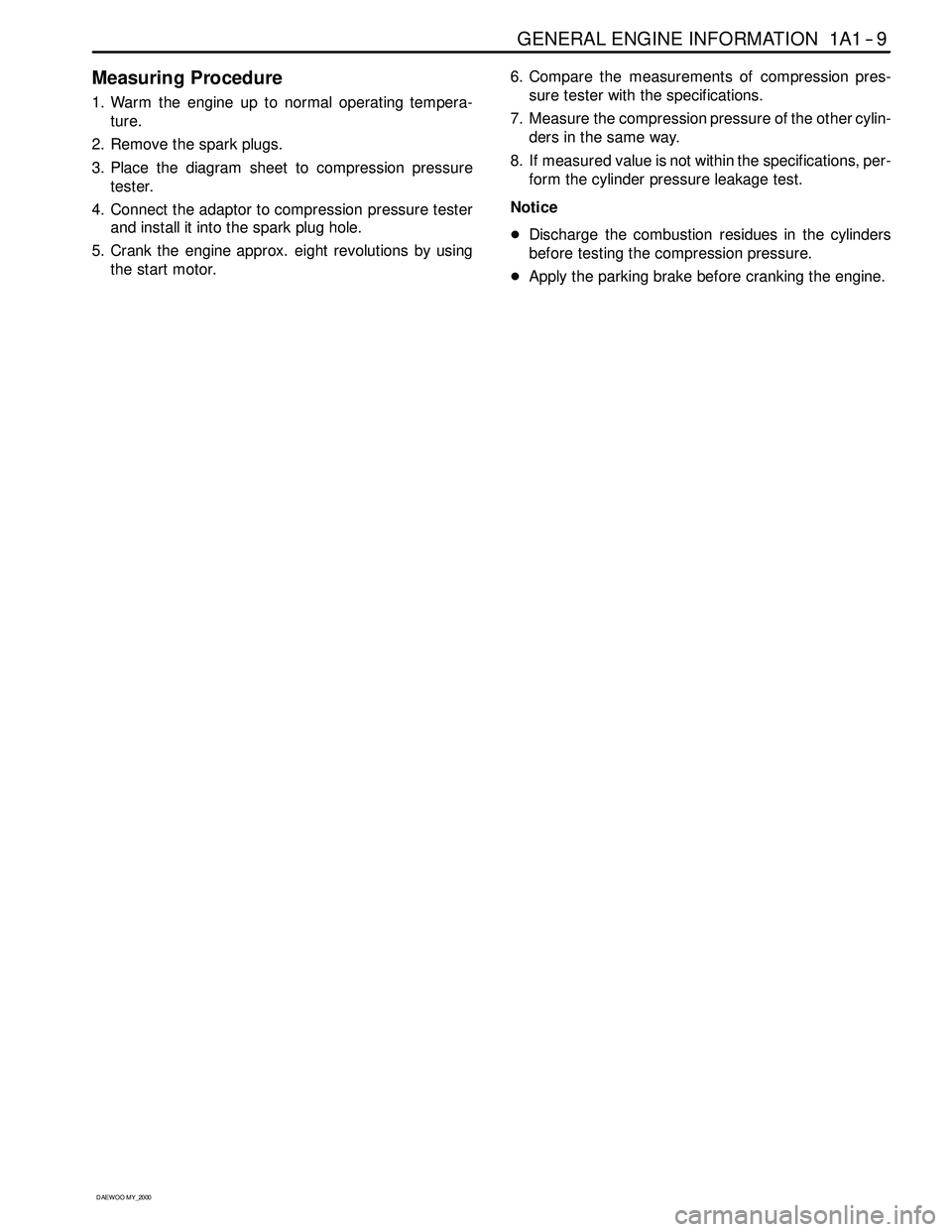
GENERAL ENGINE INFORMATION 1A1 -- 9
D AEW OO M Y_2000
Measuring Procedure
1. Warm the engine up to normal operating tempera-
ture.
2. Remove the spark plugs.
3. Place the diagram sheet to compression pressure
tester.
4. Connect the adaptor to compression pressure tester
and install it into the spark plug hole.
5. Crank the engine approx. eight revolutions by using
the start motor.6. Compare the measurements of compression pres-
sure tester with the specifications.
7. Measure the compression pressure of the other cylin-
ders in the same way.
8. If measured value is not within the specifications, per-
form the cylinder pressure leakage test.
Notice
DDischarge the combustion residues in the cylinders
before testing the compression pressure.
DApply the parking brake before cranking the engine.
Page 293 of 2053
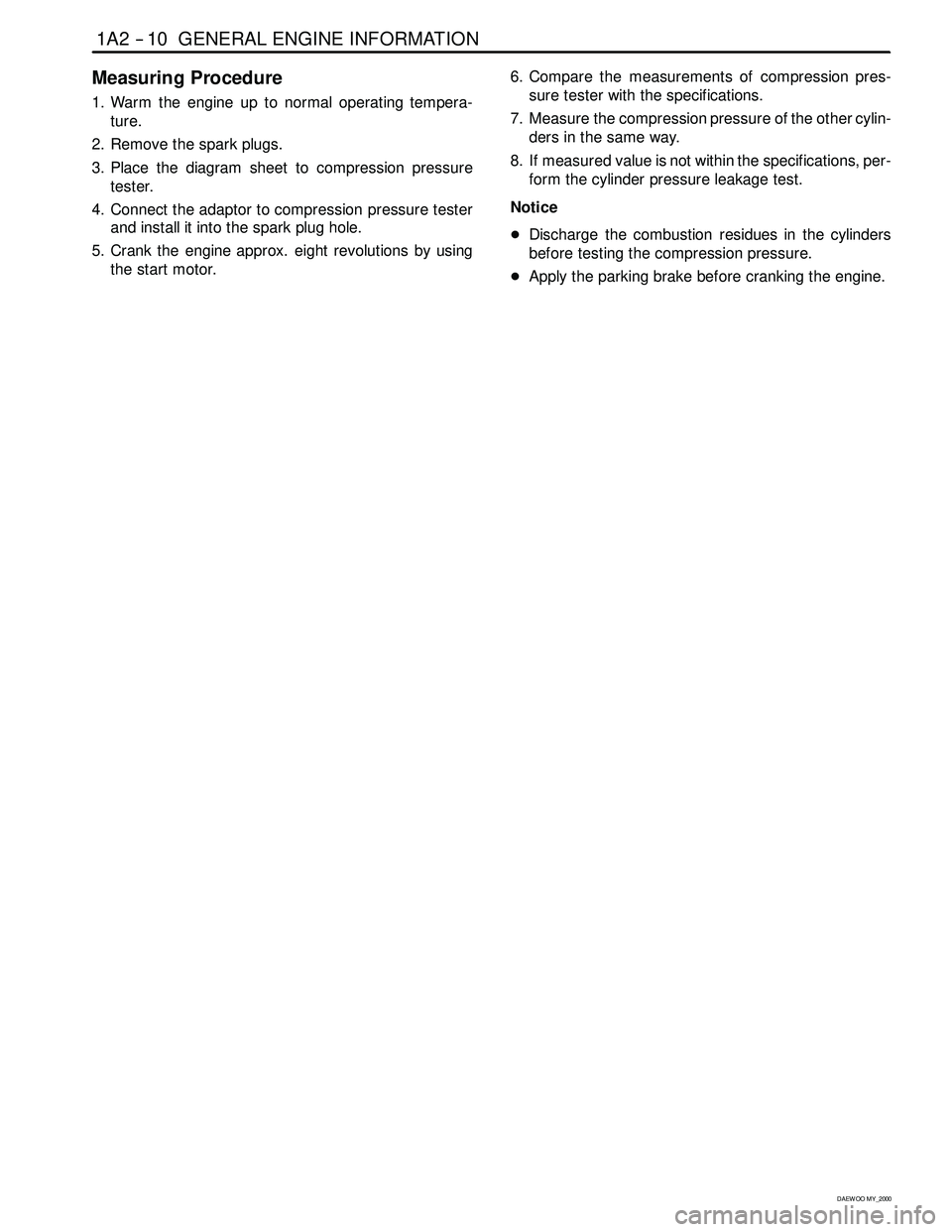
1A2 -- 10 GENERAL ENGINE INFORMATION
D AEW OO M Y_2000
Measuring Procedure
1. Warm the engine up to normal operating tempera-
ture.
2. Remove the spark plugs.
3. Place the diagram sheet to compression pressure
tester.
4. Connect the adaptor to compression pressure tester
and install it into the spark plug hole.
5. Crank the engine approx. eight revolutions by using
the start motor.6. Compare the measurements of compression pres-
sure tester with the specifications.
7. Measure the compression pressure of the other cylin-
ders in the same way.
8. If measured value is not within the specifications, per-
form the cylinder pressure leakage test.
Notice
DDischarge the combustion residues in the cylinders
before testing the compression pressure.
DApply the parking brake before cranking the engine.
Page 900 of 2053

SSANGYONG MY2002
3D-6 REAR AXLE
REAR AXLE SHAFT ASSEMBLY
With disc brake
KAA3D030
1 Brake Disc
2 Plug
3 Rear Axle Shaft
4 Nut
5 Washer
6 Parking Brake Cable7 Parking Brake Lining & Back Plate Assembly
8 Brake Caliper Assembly
9 Spring Washer
10 Bolt
11 Rear Axle Housing
Page 902 of 2053

SSANGYONG MY2002
3D-8 REAR AXLE
ON-VEHICLE SERVICE
AXLE SHAFT ASSEMBLY
(WITH DISC BRAKE)
Removal
1. Remove the tire.
KAA3D050
KAA3D070
KAA3D060
2. Release the parking brake.
3. Remove the fixing pin of parking brake.
4. After detaching the parking brake lever, detach
the cable.
5. Remove the two fixing bolt of brake caliper.
Notice: Be careful not to damage the brake oil
hose.
6. Remove the brake caliper assembly.
Notice: If replacing the brake pad only, remove the
upper fixing bolt of caliper pad and lower it.
MAINTENANCE AND REPAIR
Page 904 of 2053

SSANGYONG MY2002
3D-10 REAR AXLE
KAA3D140
KAA3D150
KAA3D130
2. Tighten the flange fixing bolts and washers with
the retainer plate.
Installation Notice
3. Assemble the plastic plug n the rear axle flange
and install the dust shield.
Installation Notice
4. Install the brake disc and caliper assembly.
Installation Notice
5. Install the parking brake cable and tire.
Tightening torque 85 - 105 N•m
KAA3D120
Installation
Clean the detached axle shaft, check the damage or
wear.
1. After checking the spline & shaft of rear axle shaft,
assemble the shaft into the rear axle housing.
Tightening Torque50 - 65 Nm
(37 - 48 lb-ft)
Tightening Torque4 - 8 Nm
(35 - 71 lb-in)